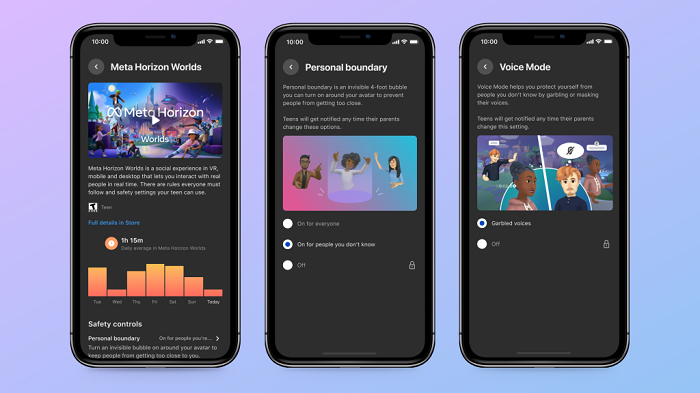Meta’s next push on its broader metaverse initiative will see the company make a bigger effort to entice younger users across to its VR experience, via new games and creation features, which will ideally attract a whole new crowd to its much-maligned virtual environment.
On this front, today, Meta has announced that it will be opening up access to its Horizon Worlds VR sandbox tool to users aged 13 to 17.
As per Meta:
“Until now, Worlds has been limited to those 18 and up, but Meta Quest is rated 13+, so we’re excited to begin opening Worlds to teens ages 13 to 17 in the US and Canada in the coming weeks with a robust set of age-appropriate protections and safety defaults. Now, teens will be able to explore immersive worlds, play games like Arena Clash and Giant Mini Paddle Golf, enjoy concerts and live comedy events, connect with others from around the world, and express themselves as they create their own virtual experiences.”
Which comes with a level of concern around potential exposure to unsavory elements in the app. Already, Horizon users have recounted sexual assault, even virtual rape, within the VR environment, which has prompted Meta to add in a range of new safety features.
Those features will be bolstered for younger users, with Meta outlining default settings and tools that parents and teens will have at their disposal.

Parents will have expanded oversight capacity, via Meta’s Family Center for Worlds, through which they’ll be able to stay across who their kids are interacting with, and what they’re doing in the VR experience.
Meta also already has its personal boundary tools, which restrict how other VR avatars can interact, while it’s also rolling out some expanded protection tools for teens specifically, including default restrictions on active status and location, and a new Voice Mode which will disguise avatar voices.
“This feature transforms the voices of people a teen doesn’t know into quiet, friendly sounds, giving teens more control over who can communicate with them. It also garbles the teen’s voice, so people they don’t know can’t hear them. We turn garbled voices on automatically for all teens by default within voice mode.”
But even so, Meta further notes that it will be rolling out Horizon Worlds access to teens very slowly, so that it can assess any potential problems and gaps in its protective measures.
At the same time, connecting with younger users seems like the best way to maximize VR take-up, through immersive experiences that can better align them with their gaming characters, as well as their real-world friends who can join them online. Which is now a key interactive element – these days, kids don’t ride their bikes down the shops and hang out with their friends, they meet up online, and engage in virtual hangouts, within which they can game, chat, etc.
Along this line, platforms like Roblox, Minecraft and Fortnite have become increasingly popular, and it therefore makes sense, by extension, that these same users would be interested in having similar experiences within more advanced VR environments.
And if Meta can hook these audiences at younger ages, they could be the ideal target audience for when its metaverse push really takes shape. Meta has repeatedly said that the metaverse will take years to reach a usable, workable stage, and with that in mind, it does seem like the current, gaming-focused teen cohort would be the perfect group to drive future adoption.
So long as it does catch on. Part of the problem with Meta’s VR experience right now is that it’s not ready, and while there are some amazing VR experiences and elements, overall, it’s not as responsive or engaging as it seems like it could be.
That will continue to improve, though, and maybe, with gradual buy-in from younger users, that’ll also, eventually, see the metaverse become a bigger element, as stemmed through younger demographics.
We’ll wait and see, but this could be a significant development within Meta’s broader plans.



